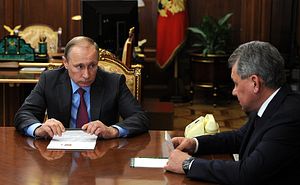Russia’s limited military intervention in Syria had two objectives. First, the influx of Russian air power and military advisors was supposed to prevent the battlefield defeat of the regime of Syrian President Bashar al-Assad, which at the outset of Russia’s military involvement in September 2015 was in serious danger of being overthrown. Second, with Russia methodically establishing military facts on the ground in Syria, Russian President Vladimir Putin wanted to make sure his country would have a major say in any eventual peace negotiations in order to guarantee that a pro-Russian regime will remain in power in Damascus (not necessarily under the leadership of Assad).
As of March 2016, Putin’s military gamble appears to have achieved both objectives. The Assad regime is currently in no danger of being overrun by opposition forces and Russia’s preeminent role in the talks of the International Syria Support Group ensures that it will have leverage during the Geneva peace talks on Syria and any future peace process. (Moscow co-chairs the ISSG – primarily due to Russian successes on the battlefield–and has become the diplomatic guarantor for the compliance of the Syrian Arab Army, the Iranian Revolutionary Guards Corps, Hezbollah, and a number of other pro-government militias to uphold a country-wide ceasefire.)
“The truly effective work by our troops has created conditions to start the peace process,” Putin said when he announced the withdrawal on Tuesday. “I feel that the objective set before the Defense Ministry and the Armed Forces is generally fulfilled, so I order the Defense Ministry to begin withdrawing the main part of our military group from the Syrian Arab Republic beginning tomorrow. I ask the Foreign Ministry to intensify the Russian Federation’s participation in organizing the peace process to resolve Syria’s problems.”
Despite the purported withdrawal, Russia will maintain its naval facility in the port of the city of Tartus as well as its airbase in the Syrian province of Latakia, both located on the Mediterranean coast. “At the same time, our base points – our maritime base in Tartus and our aviation base at the Hmeymim airbase – will function as before. They must be protected securely from land, sea and air,” said Putin.
As a consequence, the Kremlin will certainly maintain sufficient ground troops to protect both facilities and also keep medium and long-range S-400 Triumf surface-to-air missile systems, as well as Buk-M3, Tor-M2 and Pantsyr S-1 air defense missile systems in place to both dissuade external intervention and to quickly be able to intervene should the military situation tilt in favor of anti-Assad forces.
With the pullout announcement Russia apparently has embarked on a careful balancing act where on the one hand it signals the Syrian regime that a negotiated settlement is Moscow’s preferred solution and that its support is not endless. On the other hand, Moscow, by maintaining a military presence in the country, shows the opposition forces and their supporters that there simply will be no way around Russia’s client Assad during any peace negotiations—at least initially.
Moscow’s preferred outcome–next to an (unrealistic) general victory of Syrian government forces—appears to be a de facto partitioning of the country with Damascus in control of all major population centers and strategically important regions including the Mediterranean coast. As a result, it is unlikely that Russian military advisors that support operations against major urban centers will be pulled out or that Russia will suspend all close air support missions, although we are certain to see a massive decline in the number of sorties flown by the Russian military.
The decision to withdraw is in all likelihood also partially influenced by the fact that given the Russian military’s limited logistical capabilities outside Europe and the post-Soviet periphery, the operational pace of conducting 60 to 70 sorties per day could not have been sustained indefinitely, although one has to emphasize that the Syrian intervention did not draw on the core strength of the Russian Armed Forces. It is also noteworthy that Russia’s intervention in the war-torn country has offered to ample opportunities to test and showcase Russian weaponry, not an unimportant factor considering the size of Russia’s defense industry and Putin’s ambitious re-armament program to upgrade the capabilities of the Russian military.
Russia must almost certainly have notified Iran (and possibly China) of its imminent withdrawal plans and it will largely fall to Tehran (and Hezbollah) to fill the military capability gap left by the drawdown of Russian troops from the country. Iran’s Foreign Minister Mohamad Javad Zarif said in a statement that “the fact that Russia announced that it’s withdrawing part of its forces indicates that they don’t see an imminent need for resort to force in maintaining the ceasefire. That in and of itself should be a positive sign. Now we have to wait and see.”
The Russian pullout is vicariously putting pressure on Iran to either step up military support of the Assad regime or to help force an end to a conflict that has also increasingly become a drain on Iranian manpower and resources in the last few years. The withdrawal will thus have the added benefit to strengthen Russia’s position at the negotiation table vis-à-vis Iran.
Overall, Russia’s military intervention in Syria has proven that short-term military campaigns for limited political objectives will continue to be tools of statecraft in the 21st century. While it is important not to overemphasize the success of the Russian intervention, it clearly improved Russia’s position in relation to the West and safeguarded Russia’s perceived national interests in the region by keeping an ally in power. The major question remains whether Russia’s strategy is sustainable in the long-term and to what degree unintentional consequences (e.g., the deterioration of Russia-Turkey relations) will undermine Moscow’s purported short-term diplomatic and military successes in the region.

































